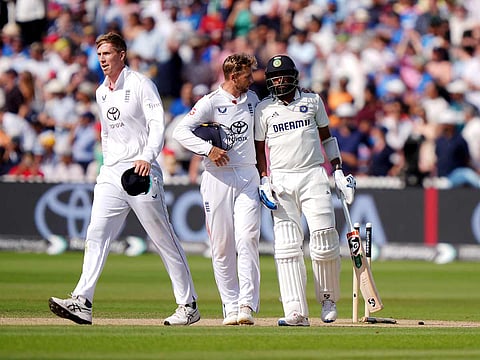Why India lost at Lord’s: Three key factors behind the defeat
England take 2-1 lead after India’s collapse exposes deeper issues with team balance

Dubai: Another Test, another final-day meltdown. For the second time in this riveting series, India dominated the early exchanges only to falter when it mattered most. At Lord’s, the pattern from the first Test re-emerged — moments of control squandered by lapses in judgement, tactical imbalance, and missed opportunities. England’s 22-run win gives them a 2-1 lead in the five-match series, but the story was far more nuanced.
Ravindra Jadeja stood at one end — weary, resolute, and unbeaten on 61 off 181 deliveries. At the other, partners came and went until the resistance ended with Jasprit Bumrah giving in to temptation and skying one to substitute fielder Sam Cook. Just like that, India’s fight ended not in disgrace, but in exhaustion.
“That was a great advert for five-day Test cricket,” said former England captain Nasser Hussain. “It was hard-fought, feisty, but played in the spirit of the game… Jadeja and the India tailenders showed so much character and fight, they didn’t deserve to be on the losing side.”
Despite flashes of brilliance across five days, India’s undoing came down to structural decisions and pressure points exposed under English conditions. Gulf News looks at three key reasons behind the defeat:
1. Too many all-rounders, too few batters
India’s decision to field a batting-heavy lower order filled with all-rounders came at a cost. With Shubman Gill carrying the top order, and the absence of a true No. 5 specialist, the team lacked stability in key phases of the chase. The exclusion of Shreyas Iyer — a batter in form — and the continued reliance on an all-rounder-heavy middle order deprived India of the anchoring presence someone like Virat Kohli would have offered. In close chases, one extra batter often makes the difference.
2. A compromised bowling formula
Jasprit Bumrah has been outstanding, claiming 12 wickets in four innings, but the need to manage his workload has forced the team to include extra bowling options. This has come at the cost of batting depth. While Ravindra Jadeja has contributed with four successive half-centuries, his primary role as a frontline spinner has come under scrutiny — just three wickets in six innings on dry English surfaces isn’t a convincing return. Washington Sundar was brought in to strike a balance, but his inclusion has neither strengthened the bowling significantly nor added enough weight to the batting.
3. Moments that tilted the Test
Test matches often turn on small moments, and India fumbled a few at critical junctures. KL Rahul’s drop of Jamie Smith early in the first innings allowed the wicketkeeper to forge an 84-run partnership with Brydon Carse, pushing England to a formidable 387. Later, in India’s second innings, a misjudged run-out involving Pant and Rahul — as the latter closed in on a century — triggered a collapse. India lost six wickets for 139, squandering a position of strength.
Lessons in loss
India’s effort at Lord’s wasn’t short on heart, but once again, it was short on execution. From team composition to on-field decisions, the margin for error in England’s backyard is razor-thin — and India found themselves on the wrong side of it. As they look ahead to the fourth Test, the questions remain the same: Can they balance the XI better? Can the top order deliver under pressure? And most of all, can they convert moments of promise into lasting dominance?
If anything, Lord’s proved that the fight is there. What’s missing is the finish.
Sign up for the Daily Briefing
Get the latest news and updates straight to your inbox








